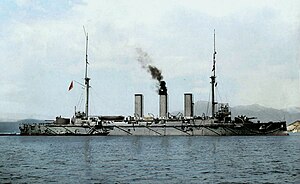Japanese cruiser Yakumo

Yakumo at anchor in Kure, 8 April 1905
|
|
| Class overview | |
|---|---|
| Operators: |
|
| Preceded by: | Izumo class |
| Succeeded by: | Azuma |
| History | |
| Name: | Yakumo |
| Namesake: | A stanza of waka |
| Ordered: | 1 September 1897 |
| Builder: | AG Vulcan Stettin, Stettin, Germany |
| Laid down: | 1 September 1897 |
| Launched: | 8 July 1899 |
| Completed: | 20 June 1900 |
| Reclassified: |
|
| Struck: | 1 October 1945 |
| Fate: | Scrapped, 20 July 1946 |
| General characteristics | |
| Type: | Armored cruiser |
| Displacement: | 9,646 t (9,494 long tons) |
| Length: | 132.3 m (434 ft 1 in) (o/a) |
| Beam: | 19.57 m (64 ft 2 in) |
| Draft: | 7.21 m (23 ft 8 in) |
| Installed power: |
|
| Propulsion: |
|
| Speed: | 20 knots (37 km/h; 23 mph) |
| Range: | 7,000 nmi (13,000 km; 8,100 mi) at 10 knots (19 km/h; 12 mph) |
| Complement: | 670 |
| Armament: |
|
| Armor: |
|
Yakumo (八雲?, sometimes transliterated as Yagumo) was an armored cruiser built for the Imperial Japanese Navy (IJN) in the late 1890s. As Japan lacked the industrial capacity to build such warships herself, the ship was built in Germany. She participated in most of the naval battles of the Russo-Japanese War of 1904–05, and was lightly damaged during the Battle of the Yellow Sea and the Battle of Tsushima. Yakumo saw no combat during World War I and began the first of many training cruises in 1917, although she was not officially reclassified as a training ship until 1931. Her last training cruise was in 1939, but the ship continued to conduct training in home waters throughout the Pacific War. Yakumo became a repatriation transport after the war and was broken up in 1946–47.
The 1896 Naval Expansion Plan was made after the First Sino-Japanese War, and included four armored cruisers in addition to four more battleships, all of which had to be ordered from overseas shipyards as Japan lacked the capability to build them itself. Further consideration of the Russian building program caused the IJN to believe that the battleships ordered under the original plan would not be sufficient to counter the Imperial Russian Navy. Budgetary limitations prevented ordering more battleships, and the IJN decided to expand the number of more affordable armored cruisers to be ordered from four to six ships, believing that the recent introduction of tougher Krupp cemented armor would allow them to stand in the line of battle. The revised plan is commonly known as the "Six-Six Fleet". The first four ships were built by Armstrong Whitworth in the United Kingdom, but the last two ships were built in Germany and France. To ensure ammunition compatibility, the IJN required their builders to use the same British guns as the other four ships. In general, the IJN provided only a sketch design and specifications that each builder had to comply with; otherwise each builder was free to build the ships as they saw fit. Unlike most of their contemporaries which were designed for commerce raiding or to defend colonies and trade routes, Yakumo and her half-sisters were intended as fleet scouts and to be employed in the battleline.
...
Wikipedia
